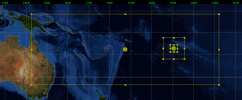Hello to the community,
First, I hope I posted this thread in the right section, as ndown is (to me) kind of inbetween WPS & WRF. Then, I beg for your indulgence as I'm new to WRF and its whole environment (i.e. Linux, supercomputing) ; but as you all I bet, passion got me here, willing to learn. This post will expose my project and may contain a lot of different questions which I may assign a number to in order to keep track.
I'd also like to thank you in advance for your help and advices.
Context :
High resolution modelisation over a tropical island in the center of South Pacific. Downscaling from previous WRF simulation (wrfouts) d01 at 21km (33 vert. levels) with ndown, which will serve as input to a suite of nested domains d02 at 7km (ratio : 3) and finally d03 at 2,33 km (ratio : 3) - vertical refinement with a factor 2 is not excluded yet. The previous WRF simulation already was a downscaling, hence let's call the "original" wrfouts d02* (star) - d02* = d01.
I edited my namelist in order to have 3 domains.
d01 is set exactly as d02* i.e. : dx = dy = 21 ; 441 x 166 grid points ; 33 vert. levels
d02 is set this way : dx = dy = 7 ; 151 x 151 grid points ; 33 vert. levels (or possibly 66 if refinement) ; i_start : 310 ; j_start : 66
d03 is set as : dx = dy = 2,33 ; 151 x 151 grid points ; 33 vert. levels (or possibly 66 if refinement) ; i_start : 51 ; j_start : 51

Figure 1 : screenshot from WRF Domain Wizard. Domains d02 and d03 center are superimposed.
For the time period, I chose 4 days to run first tests.
As I understood what I read from the User's Guide and tutorial, I intend to run ndown with the wrfouts from original simulation d02* (i.e. my d01) with a refinement ratio of 3 to prepare input files in order to run with WRF my nested domains d02 and d03. For now, I identified the d02* wrfout files that I'll use, placed them in appropriate directory and renamed them wrfout.d01 ; but I can't yet figure out some points to go further.
Questions :
0) Are my explanations clear enough ?
1) Does my config look appropriate, i.e. is it compatible to use ndown to force 2 nested domains in WRF ?
3) What if I don't mange to get the intermediate files of the previous simulation ?
That's all for the moment. This might be a long run thread where I'll post further questions while progressing.
Thanks for your help one more time.
First, I hope I posted this thread in the right section, as ndown is (to me) kind of inbetween WPS & WRF. Then, I beg for your indulgence as I'm new to WRF and its whole environment (i.e. Linux, supercomputing) ; but as you all I bet, passion got me here, willing to learn. This post will expose my project and may contain a lot of different questions which I may assign a number to in order to keep track.
I'd also like to thank you in advance for your help and advices.
Context :
High resolution modelisation over a tropical island in the center of South Pacific. Downscaling from previous WRF simulation (wrfouts) d01 at 21km (33 vert. levels) with ndown, which will serve as input to a suite of nested domains d02 at 7km (ratio : 3) and finally d03 at 2,33 km (ratio : 3) - vertical refinement with a factor 2 is not excluded yet. The previous WRF simulation already was a downscaling, hence let's call the "original" wrfouts d02* (star) - d02* = d01.
I edited my namelist in order to have 3 domains.
d01 is set exactly as d02* i.e. : dx = dy = 21 ; 441 x 166 grid points ; 33 vert. levels
d02 is set this way : dx = dy = 7 ; 151 x 151 grid points ; 33 vert. levels (or possibly 66 if refinement) ; i_start : 310 ; j_start : 66
d03 is set as : dx = dy = 2,33 ; 151 x 151 grid points ; 33 vert. levels (or possibly 66 if refinement) ; i_start : 51 ; j_start : 51

Figure 1 : screenshot from WRF Domain Wizard. Domains d02 and d03 center are superimposed.
For the time period, I chose 4 days to run first tests.
As I understood what I read from the User's Guide and tutorial, I intend to run ndown with the wrfouts from original simulation d02* (i.e. my d01) with a refinement ratio of 3 to prepare input files in order to run with WRF my nested domains d02 and d03. For now, I identified the d02* wrfout files that I'll use, placed them in appropriate directory and renamed them wrfout.d01 ; but I can't yet figure out some points to go further.
Questions :
0) Are my explanations clear enough ?
1) Does my config look appropriate, i.e. is it compatible to use ndown to force 2 nested domains in WRF ?
2) Why aren't he wrfouts from d02* the only input files I need to run ndown ?I don't have (yet..?) the specified intermediate files (FILE) in ndown tutorial Step 1.2.1 ; moreover I don't see the point of creating met_em from these files as I already got d02* wrfouts meteorological data
3) What if I don't mange to get the intermediate files of the previous simulation ?
That's all for the moment. This might be a long run thread where I'll post further questions while progressing.
Thanks for your help one more time.
